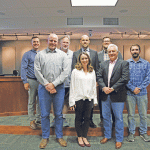Thompson School District faces criticism over driver shortage response
By Brendan Henry
The Surveyor
A national bus driver shortage is making it harder for kids to get to school in Berthoud with parents and drivers saying the school district is to blame. Without enough bus drivers, the Thompson School District (TSD) has been forced to implement a rolling bus route outage, where routes are discontinued for seven school days at a time to accommodate for the lack of drivers. Parents are then responsible for taking their children to school for those seven days.
Berthoud parents and bus drivers have since found ways to adapt, but many are displeased with the current route outage plan.
Stu Boyd, Berthoud’s representative to TSD’s school board, is aware of the community concern regarding the route outages. He claims that the transportation department contacted and observed the surrounding school districts and followed suit. Boyd says that TSD was among the last districts to adopt rolling outages. The decision to rotate outages was put off as long as the district could, but as the impact of the driver shortage spread, it pushed the board to make the change in an attempt to create an equitable system, according to Boyd.
There was no request for public input in the decision to implement the route outages—at least to Boyd’s knowledge—and in his opinion, it was not necessary. Boyd says that he believes Berthoud was the last to be added to the outage rotation, and ultimately deems the decision as fair given the circumstances.
As to a definitive solution, he believes the only way to solve the issue definitively is to get more drivers in the district.
“This is a manpower or a womanpower situation and that’s really the only way to fix it,” Boyd said.
He said that the board understands the burden that has been placed on parents within the community and that they appreciate parents voicing their concerns during school board meetings. The school board is not currently working on a new plan, but Boyd says the transportation department is trying to find ways to recruit more drivers.
Students have taken the brunt of the rolling route outages, but parents are feeling the effects too. Two parents in the Berthoud community, Emily Boyd (no relation to TSD board member Stu Boyd) and Kelly Seaton have been vocal about their displeasure over route outages.
A mother in rural Berthoud, Boyd was notified of the rolling route outages in early December. Since the outages, she has spent at least 50 minutes—and sometimes an hour and a half—of her mornings to get her kids to school due to the long drop-off line and the 10-mile round trip. After that, Boyd has a 45-minute commute to her work in Boulder.
For seven school days at a time, she is losing around three hours of work each day. Boyd understands that although her job is flexible, not everyone has the same luxury.
“A lot of folks in our community, they do shift work,” Boyd explained. “So sometimes their shifts are 12 hours, so if they can only be there for five hours they’re missing out on at least half of the day’s pay every single time they have to transport their kids from school, which can be financially impactful for families.”
Compared to urban and suburban school bus routes, rural ones require additional time and resources for school districts. However, Boyd believes that rural areas should get priority because they lack transportation infrastructure for kids. In her location, there is nowhere she would deem safe for her kids to walk on the roadside.
Emily Boyd has expressed her concerns in multiple ways, initially writing letters to the transportation department, TSD Superintendent Marc Schaffer and Stu Boyd. While they were responsive, she does not believe their responses were entirely sufficient, seeing no clear path forward to resolving the problem.
While Emily Boyd has identified things that she perceives as issues with the new plan, she has also contributed ideas to rectify the problem. She would like to see an increase in the transportation budget and bonuses that could keep drivers in the district. Boyd also said she would like to see TSD stop using full-sized buses to pick up a small number of kids, something that has been confirmed by a current district driver.
Kelly Seaton is another parent in Berthoud who helps as a school crossing guard in town. She has seen the difference the route outages have caused firsthand.
“By taking away one route for seven school days, especially at Berthoud Elementary, we’re adding at minimum 50 cars to an already congested drop-off system,” Seaton explained.
Congested drop-off areas also increase the risk of injury for children. For Seaton, this is not a matter of if—but when.
“We have families that have never driven their kids to school because they’ve always relied on bus transportation,” she said. According to Seaton parents are now “trying to figure out bus loops or dropping kids off in the middle of the road and letting them cross the opposite direction and it’s a madhouse.”
Instead of getting mad though she wants to know what is going on. Using her connections within the transportation department, Seaton has spoken with drivers and has gained some additional insight into the issue.
She claims that drivers were initially unwilling to give up their Berthoud routes and stood firm until the district forced them to, something that rubbed drivers the wrong way as they got little to no input in the decision. Seaton said they were voluntold, a hybrid word combining ‘volunteer’ and ‘told’ implying that someone else has volunteered you for a task you had no option to say no to. On top of this, Berthoud drivers are now having to drive double routes, causing some children to be upwards of 45 minutes late to school, Seaton said.
To help alleviate some of the burden on parents when their route is up for outage, Seaton is a part of a rotating carpool in town that helps get other parents’ kids to school.
Unhappy with the lack of public input, Seaton has voiced some potential solutions. She believes that the requirement for everyone involved in the transportation department like dispatchers to have a CDL—a commercial driver’s license that is required to drive a school bus—hinders TSD’s effort to recruit new drivers. Like Boyd, she would like to see more competitive wages and benefits to draw more people in. Seaton said she knows there is no simple solution, but does not feel the current plan is the correct one.
One misconception about the bus driver shortage is the transportation budget. Some parents are under the impression that the transportation budget has not changed in 15 years, but according to TSDs Chief Financial Officer Gordon Jones, this is not true. Jones says that the transportation budget for the 2009-10 fiscal year was approximately $933,000 and the current fiscal year of 2023-24 is now at $1,909,945. This budget mostly consists of vehicle maintenance and fuel, but also includes money for extra hours and substitute drivers. Drivers are paid out of a separate budget for salaries and benefits for student transportation, for 2023-24 the budget is approximately $5 million.
That budget pays around 50 to 60 drivers who cover about 60 routes a day, according to Matt Payne, the director of transportation for the district. Payne would know as he has had to join the 50 to 60 drivers to help run routes due to the shortage, keeping them out of the office and extending their time away from home to about 12 hours a day.
With staff out of the office driving routes, Payne admits that communication with parents is not where he would like it to be. Currently, the department works with the district’s communications officer to use automated phone calls and mail. Payne said he calls people back who either called in with questions or sent an email inquiry when he is in the office and not out driving.
Children are a top priority for the transportation department and so are the drivers Payne said. The department does its best to allow drivers to have options when it comes to their schedules. Some drivers want limited routes while others need more full-time work. Payne hopes that this methodology will attract drivers and help retain the ones they have.
Despite the heavy workload for himself and his supervisors, Payne says that he is pleased with the district.
“This district, this community, the amount of support that is there, it really is, it’s impressive. This district leadership, our admin, our school board, they are checking in with us constantly,” he said.
The Surveyor spoke to two bus drivers, one current and one former, on the condition of anonymity for this story. The driver currently working in the district does not share Payne’s optimism. They are critical of the school board’s use of the word “equity,” finding a lack of said equity in the routes they drive themselves.
“You know, this equity thing that they’re talking now, it’s not so much equity when you’re dropping (a route of) 40 kids and (instead) you’re only picking up 10,” the driver said. “So stop throwing that in my face because that’s not really the truth.”
Aside from dropping routes with larger numbers of children for smaller numbers of children, the driver has experienced other internal issues within the department. One ongoing issue detailed by the driver is a broken garage door that leads to the bus washing area. Instead of paying $3,000 to fix it, the driver said, the district pays someone to come in and wash the buses, which turns out to be more expensive over time.
Another internal issue, according to the driver, is that supervisors in the department are not mandated to go through leadership courses like many other employers require. They are simply selected internally through an interview process and are given the position without any further professional training. The driver also says that the review process for drivers is no longer done by a higher-up, the review paperwork is handed directly to the drivers to fill out for themselves.
According to the driver, some routes have consisted of over 100 miles of travel, something that they say is not feasible. The stress, on top of equal pay increases not based on merit or time spent with the district, has caused drivers to quit. With no incentive to stay and no attempt at retaining drivers, the driver says all the small things are starting to add up negatively.
A former district driver provided additional insight into the current situation. During and after the COVID-19 pandemic, many older drivers decided to hang up their spurs, and according to the former driver, those boots have been left unfilled since.
The former driver says that being a bus driver is not easy, having to get up early in the morning, deal with potentially unruly children, and then go back out in the afternoon after a long morning route. To top it off, they only get paid a part-time wage, and in the TSD, the wage is far from livable the former driver said, pushing younger drivers to other areas like Greeley.
“If I’m a young man and I can’t afford to rent an apartment in Loveland, I can’t afford to rent an apartment of course in Berthoud. Maybe I can rent something up in Fort Collins, but if the cheapest I can find is going to be over in Greeley, why would I not just go work for Greeley as a school bus driver? And I’ve seen a lot of people do that. They’ve lost people who do that,” the former driver said.
As noted by the former driver, younger people with CDLs can take their skills to companies like Amazon or UPS and get full-time pay with benefits. The former driver has also experienced other districts where they offer eight hours of work a day, assigning additional duties like washing the buses or driving for field trips to those who are seeking them.
From what the former driver has seen in other districts, TSD has possible alternatives to the current plan: Changing bell times for each school, training teachers, janitors or cafeteria workers to drive, paying more for each driver’s insurance, targeted recruiting for retirees who have the free time and are looking for extra income and even implementing a pickup range. For example, families who live within five miles of the school would be required to provide transportation and those outside of the radius would be picked up by the school district.
“I mean, there’s so many different options and stuff like that. But all of them are going to require some kind of willingness and consensus to solve the problem. And in the end, the problems are pretty big,” the former driver said.
- August, 05 2021

Thompson School District says masks o...
Thompson School District communicated officially with students and staff today that they will not require...
- February, 25 2021

Thompson middle, high school students...
Thursday morning, the Thompson School District (TSD) announced that secondary students (middle and high school)...
- June, 21 2019

School Board approves 2019-20 budget,...
By Dan Karpiel The Surveyor In what marked the final meeting of the Thompson School...
- April, 11 2019

BHS’ Ivy Knudsen earns prestigi...
By Dan Karpiel The Surveyor The wait is the hardest part. For Berthoud High School...
- June, 28 2023

Board of Education makes multiple bud...
By Brendan Henry The Surveyor Thompson School District’s (TSD) Board of Education held its regularly...
- June, 02 2016

Characters come to life during author...
Fourth graders Katrina Riguito, dressed as Hermione Granger from the Harry...
- Asher Architects builds projects from...

- More than a market, a family legacy

- Colorado business confidence is impro...

- Community Calendar & Legal Notice...

- Community Calendar & Legal Notice...

- Community Calendar & Legal Notice...


Unified basketball comes to Turner Middle School
Community News

Mike Grace says goodbye as Brett Wing joins town board
Community News
POLICEBLOTTER
Community News
Northern Water sets C-BT quota at 70% for 2024
Community News

Emotions run high during Revere Property hearing
Community News
Snowpack at 119% above normal
Community News

Karspeck to serve third term as Berthoud mayor
Community News
COMMUNITY CALENDAR:
Community Calendar – add an event
Homestead Fine Art Gallery First Fridays OPEN HOUSE
03 May 4:00 PM - 7:00 PM
Homestead Fine Art Gallery First Fridays OPEN HOUSE
07 Jun 4:00 PM - 7:00 PM
Homestead Fine Art Gallery First Fridays OPEN HOUSE
05 Jul 4:00 PM - 7:00 PM
Homestead Fine Art Gallery First Fridays OPEN HOUSE
02 Aug 4:00 PM - 7:00 PM
Homestead Fine Art Gallery First Fridays OPEN HOUSE
06 Sep 4:00 PM - 7:00 PM
Homestead Fine Art Gallery First Fridays OPEN HOUSE
04 Oct 4:00 PM - 7:00 PM














